Search the Special Collections and Archives Portal
Search Results
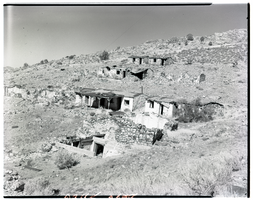
Film transparency of a ghost town, Delamar, Nevada, 1956
Date
1956
Archival Collection
Description
A view of some of the abandonded buildings on a hillside in Delamar, Nevada. One of the structures has a covered porch Delamar, Nevada, nicknamed The Widowmaker, is a ghost town in central eastern Nevada, USA along the east side of the Delamar Valley. During its heyday, primarily between 1895 and 1900, it produced $13.5 million in gold. In 1889, prospectors John Ferguson and Joseph Sharp discovered gold around Monkeywrench Wash. A mining camp was then born west of the Monkeywrench Mine. It was called Ferguson. In April 1894, Captain Joseph Raphael De Lamar bought most of the important mines in the area and renamed the Ferguson camp as Delamar. In the same year, a newspaper called the Delamar Lode began publication and a post office was opened. Soon, the new settlement boasted more than 1,500 residents, a hospital, an opera house, churches, a school, several businesses and saloons. Most buildings were made of native rock. By 1896, the Delamar mill was handling up to 260 tons of ore daily. Water for the camp was pumped from a well in Meadow Valley Wash, some twelve miles away. Supplies and materials traveled even further, by mule team over mountainous terrain from the railroad head at Milford, Utah, which was 150 miles from Delamar. Silicosis The gold in the Delamar mines was embedded in quartzite which when crushed created a fine dust. Miners breathing the dust often developed silicosis and the town became known as a "widow-maker." Many ruins now stand semi-intact in the Delamar ghost town region. Foundations can easily be seen from adjacent hills. There are two graveyards, which have been vandalized. The area is honeycombed with mines and mineshafts, but in recent years the main shaft has been blasted closed. Wild horses roam the area. The nearby dry lake is known to pilots as Texas Lake because its outline resembles the state of Texas.
Image
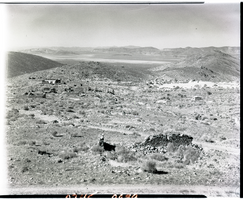
Film transparency of a ghost town, Delamar, Nevada, 1956
Date
1956
Archival Collection
Description
A view of some of the abandonded buildings in Delamar, Nevada, taken from a nearby hill. Delamar, Nevada, nicknamed The Widowmaker, is a ghost town in central eastern Nevada, USA along the east side of the Delamar Valley. During its heyday, primarily between 1895 and 1900, it produced $13.5 million in gold. In 1889, prospectors John Ferguson and Joseph Sharp discovered gold around Monkeywrench Wash. A mining camp was then born west of the Monkeywrench Mine. It was called Ferguson. In April 1894, Captain Joseph Raphael De Lamar bought most of the important mines in the area and renamed the Ferguson camp as Delamar. In the same year, a newspaper called the Delamar Lode began publication and a post office was opened. Soon, the new settlement boasted more than 1,500 residents, a hospital, an opera house, churches, a school, several businesses and saloons. Most buildings were made of native rock. By 1896, the Delamar mill was handling up to 260 tons of ore daily. Water for the camp was pumped from a well in Meadow Valley Wash, some twelve miles away. Supplies and materials traveled even further, by mule team over mountainous terrain from the railroad head at Milford, Utah, which was 150 miles from Delamar. Silicosis The gold in the Delamar mines was embedded in quartzite which when crushed created a fine dust. Miners breathing the dust often developed silicosis and the town became known as a "widow-maker." Many ruins now stand semi-intact in the Delamar ghost town region. Foundations can easily be seen from adjacent hills. There are two graveyards, which have been vandalized. The area is honeycombed with mines and mineshafts, but in recent years the main shaft has been blasted closed. Wild horses roam the area. The nearby dry lake is known to pilots as Texas Lake because its outline resembles the state of Texas.
Image
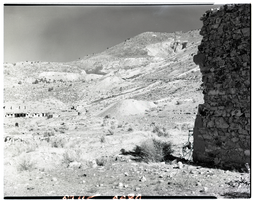
Film transparency of a ghost town, Delamar, Nevada, 1956
Date
1956
Archival Collection
Description
Some of the abandonded buildings in Delamar, Nevada. A tailing pile from one of the mines is visible in the center of the photograph. A stone structure is visible on the right side of the photograph. Delamar, Nevada, nicknamed The Widowmaker, is a ghost town in central eastern Nevada, USA along the east side of the Delamar Valley. During its heyday, primarily between 1895 and 1900, it produced $13.5 million in gold. In 1889, prospectors John Ferguson and Joseph Sharp discovered gold around Monkeywrench Wash. A mining camp was then born west of the Monkeywrench Mine. It was called Ferguson. In April 1894, Captain Joseph Raphael De Lamar bought most of the important mines in the area and renamed the Ferguson camp as Delamar. In the same year, a newspaper called the Delamar Lode began publication and a post office was opened. Soon, the new settlement boasted more than 1,500 residents, a hospital, an opera house, churches, a school, several businesses and saloons. Most buildings were made of native rock. By 1896, the Delamar mill was handling up to 260 tons of ore daily. Water for the camp was pumped from a well in Meadow Valley Wash, some twelve miles away. Supplies and materials traveled even further, by mule team over mountainous terrain from the railroad head at Milford, Utah, which was 150 miles from Delamar. Silicosis The gold in the Delamar mines was embedded in quartzite which when crushed created a fine dust. Miners breathing the dust often developed silicosis and the town became known as a "widow-maker." Many ruins now stand semi-intact in the Delamar ghost town region. Foundations can easily be seen from adjacent hills. There are two graveyards, which have been vandalized. The area is honeycombed with mines and mineshafts, but in recent years the main shaft has been blasted closed. Wild horses roam the area. The nearby dry lake is known to pilots as Texas Lake because its outline resembles the state of Texas.
Image
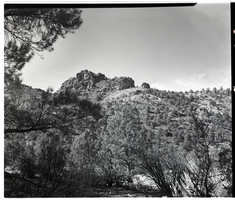
Film transparency of the Beaver Dam area near Carp, Nevada, November, 1954
Date
1954-11
Archival Collection
Description
Beaver Dam area east of Carp, Nevada. Carp, Nevada is an unincorporated community in Lincoln County, Nevada, United States located 35 miles (56 km) south of Caliente. It sits on the Meadow Valley Wash, which empties into Lake Mead. Carp was originally a small railroad station for the Union Pacific Railroad. The post office started under the name of "Carpsdale" on June 29, 1918, but was rescinded. It then officially opened under the name of "Cliffdale" June 7, 1921 and changed yet again to "Carp" December 1, 1925. The Carp post office remained open to serve rural ranches until July 1, 1974, when it closed permanently. Little remains of Carp today except a railroad siding usually occupied by idling trains, and the remains of the watering reservoir.
Image
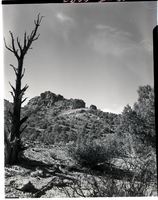
Film transparency of the Beaver Dam area near Carp, Nevada, November, 1954
Date
1954-11
Archival Collection
Description
Beaver Dam area east of Carp, Nevada. Carp, Nevada is an unincorporated community in Lincoln County, Nevada, United States located 35 miles (56 km) south of Caliente. It sits on the Meadow Valley Wash, which empties into Lake Mead. Carp was originally a small railroad station for the Union Pacific Railroad. The post office started under the name of "Carpsdale" on June 29, 1918, but was rescinded. It then officially opened under the name of "Cliffdale" June 7, 1921 and changed yet again to "Carp" December 1, 1925. The Carp post office remained open to serve rural ranches until July 1, 1974, when it closed permanently. Little remains of Carp today except a railroad siding usually occupied by idling trains, and the remains of the watering reservoir.
Image
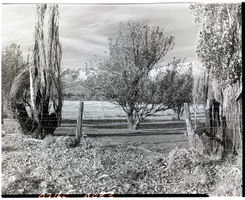
Film transparency of the Ruby Mountain Range, Elko County, Nevada, October, 1955
Date
1955-10
Archival Collection
Description
The Ruby Mountain Range in Elko County, Nevada, as seen through a stand of trees.
Image
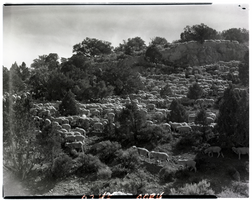
Film transparency of a western sheep drive in Northern Nevada, circa 1940s-1950s
Date
1940 to 1959
Archival Collection
Description
A herd of sheep being driven over a mountain in Northern Nevada.
Image

Film transparency of a duck hunter in a blind, Overton, Nevada, January, 1956
Date
1956-01
Archival Collection
Description
A duck hunter hides in a blind near a row of decoy ducks in the water along the Overton Arm of Lake Mead, Nevada. Overton is an Unincorporated Town located in Clark County, Nevada in Moapa Valley 65 mi (105 km) northeast of Las Vegas, Nevada, on the north end of Lake Mead. The town is home to Perkins Field airport and Echo Bay Airport.
Image
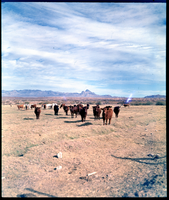
Film transparency of a herd of cattle near Warm Springs, Nevada, December, 1954
Date
1954-12
Archival Collection
Description
A herd of cattle in the desert near Warm Springs, Nevada.
Image
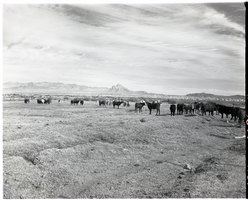
Film transparency of cattle, Warm Springs, 1954
Date
1954
Archival Collection
Description
A herd of cattle in the desert near Warm Springs, Nevada.
Image
Pagination
Refine my results
Content Type
Creator or Contributor
Subject
Archival Collection
Digital Project
Resource Type
Year
Material Type
Place
Language
Records Classification
